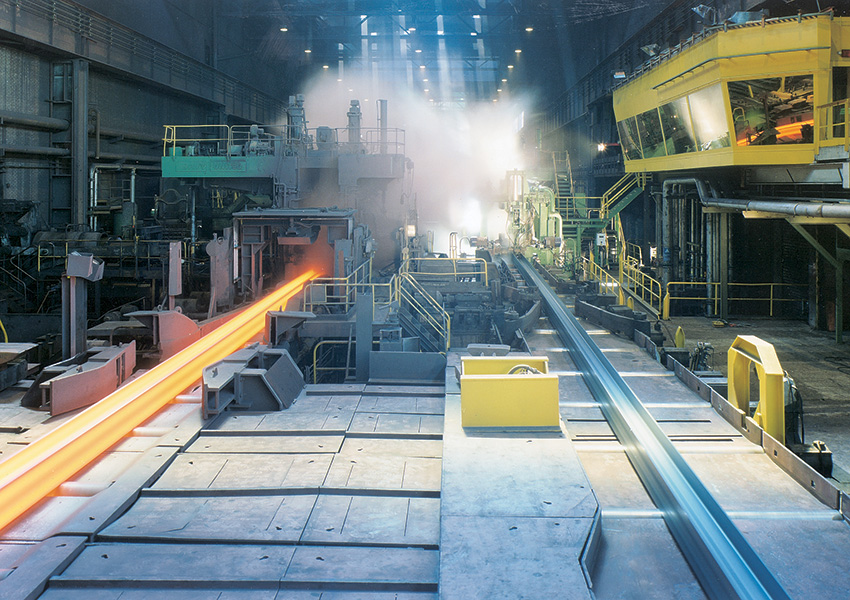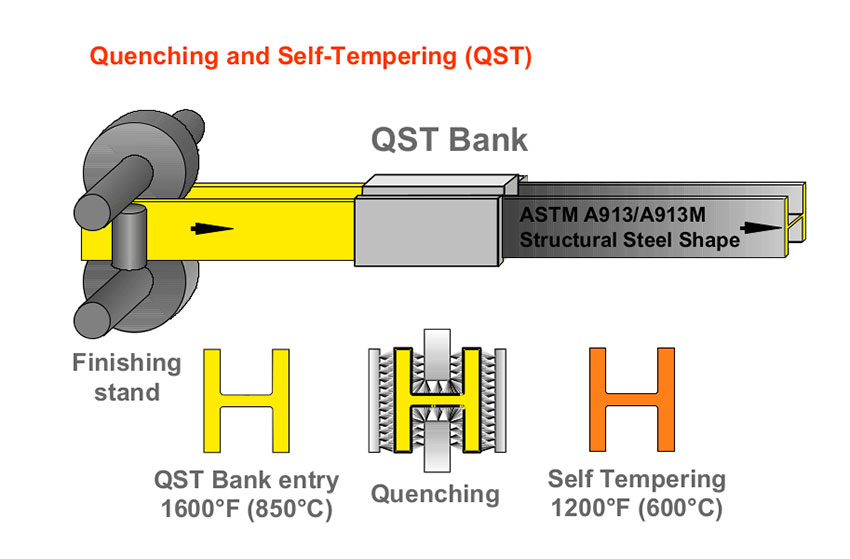Not Quite Your Grandfather's Steel
Learning Objectives:
- Identify properties of A913 high-strength steel that offer advantages in strength to-weight ratios, spatial efficiency, weldability, onsite operations, and other aspects of contemporary design and construction.
- Demonstrate a working familiarity with the quenching and self-tempering (QST) process and the properties it imparts to A913 steel.
- Identify several recent and contemporary construction projects that have used A913 steel of various grades; understand how these case studies can inform future design decisions and material specifications.
- Recognize the long-range environmental effects of designing and building with A913 and other high-strength steels; understand in what senses descriptions like “green steel” or “sustainable steel” are meaningful.
Credits:
This course is approved as a Structured Course
This course can be self-reported to the AANB, as per their CE Guidelines
Approved for structured learning
Approved for Core Learning
This course can be self-reported to the NLAA
Course may qualify for Learning Hours with NWTAA
Course eligible for OAA Learning Hours
This course is approved as a core course
This course can be self-reported for Learning Units to the Architectural Institute of British Columbia
The strength, durability, and recyclability of structural steel make it an essential tool for architects and engineers with an eye on the future. Advances in metallurgical science and fabrication techniques make it possible for less material to bear more load and occupy less space, thus economizing on the material's quantity and cost without compromising its structural integrity. In a world where professionals, clients, and the general public are increasingly conscious of the carbon and energy footprints of building materials, and where minimizing resource extraction and waste is a higher priority than in the past, high-strength structural steel is a prudent and logical choice, even plausibly a sustainable one.
The latest generation of high-strength, low-alloy steel, American Society for Testing and Materials (ASTM) specification A913, was introduced in 1993. This structural-quality steel is produced through a thermomechanical control process known as quenching and self-tempering (QST) that involves cooling and reheating so as to retain energy in the material and induce chemical changes in the layers of the steel as it assumes its form.

Image courtesy of Binyan Studios and BIG – Bjarke Ingels Group
The Spiral, designed by BIG – Bjarke Ingels Group and located in the fast-rising Hudson Yards district on Manhattan's West Side, uses grade 65 A913 combined with grade 50 A992 in some perimeter columns.
Two major manufacturers currently provide A913 steel to the North American market: ArcelorMittal and Nucor-Yamato, a joint venture between Nucor Steel of Charlotte, N.C., and Yamato Kogyo Group of Himeji, Hyogo, Japan. A913 has been incorporated into worldwide construction standards, including the American Institute of Steel Construction (AISC) Steel Construction Manual and Seismic Design Manual.
A913 represents an advance over a previous high-strength specification, ASTM A992, which remains “the most common specification used for wide-flange sections in the North American market,” observes Shelley C. Finnigan, global technical sales engineer at the Chicago office of Luxembourg City-based manufacturer ArcelorMittal. Levels of carbon and other alloy components in A913 are kept low, and its strength-to-weight ratio is high. QST is part of the production line, not a separate treatment; “because this is an in-line process,” Finnigan continues, “and because we don't have to add really expensive alloying elements to the material, then we are able to really tightly control the cost, and so the price of the material for the buyer actually is extremely competitive on the market.”

Photo courtesy of Finnigan, Charnish, and Chmielowski
ArcelorMittal’s quenching and self-tempering (QST) process, Differdange, Luxembourg.
“High-strength steel in its basic form is a way to do more with less,” says Tabitha S. Stine, director of the Construction Solutions Services Group at domestic steelmaker Nucor's office near Chicago. “That means we can build with less steel, we can go higher, we can go longer spans, we can meet what's called serviceability constraints: deflection, vibration. You're building a hospital, you have high-end equipment—these are not things that were needed 100 years ago, but we have to keep building and evolving in the world that we're in, and steel [structures] can't be the same as the ones that our grandfathers built and designed. It has to evolve.”
The reduction of steel tonnage from selecting A913 over other types of steel varies but is nontrivial. Renewed interest in using ASTM A913 has resulted in enhancements of the QST process, allowing one steel producer to realize a weight savings of 15 to 25 percent when switching from A992. This translates to significant material cost savings, reduced foundation requirements, and smaller capacity cranes. Each ton of steel that is eliminated reduces the overall CO2-equivalent output for the structure. Long span trusses can see a weight savings of 15 to 25 percent in members. This weight savings reduces the overall truss dead load, which allows for the design of smaller sections throughout the truss. When switching to steel produced by this enhanced process, column size is expected to decrease by 2 footweights within the same section family. Compared with concrete columns, the same research estimates that each 65 ksi W14x398 column saves 65 percent in square footage over an equivalent concrete column bearing the same axial load, 6,000 kips. Another benefit of this process—though still being researched (see below)—is possibly less need for preheating during welding.
“We've done a tremendous amount of work of quantifying not just the strength and man-hour savings, but also looking at the carbon savings,” says Stine. “So, when you reduce your tonnage by 20 percent, how much carbon are you eliminating in your global warming potential? But now let's quantify the heat, the man-hours, and how does that translate to carbon and sustainability savings on the job? . . . When you visit that guy, all he does all day is hold that cherry on the steel to warm it up, how much energy are we losing, what kind of safety situation do we have there, and how do we change the conversation for efficiency and innovation in construction?”
Jeffrey Smilow, executive vice president and managing director for building structures at WSP, summarizes the case for using A913 succinctly: “Smaller shapes are the benefit with the higher strength; less built-up material, which means less cost in production. [It's] readily available because now it's produced in the States, whereas years ago, you could not get this material in the States. Architects as well as non-architects are definitely in today's day and age interested in a more sustainable product, and the A913s as they're manufacturing in this country, have a better sustainability, a lesser carbon footprint, and it's improving constantly.”
Although structural engineers are more directly concerned with specific types, grades, and properties of steel, architects and other members of the design team can benefit from being conversant with them as well. “Sometimes when the term 'high-strength steel' comes up in the context of a project team, a lot of initial reactions might be hesitancy to engage with particular types,” Finnigan says. “If the discussion of high-strength steel is coming up from the structural engineer on a project, it's worth investigating, because they're probably trying to identify the most effective place in the building to integrate the high-strength steel, and they're taking into account more layered decision factors than just 'Is it high-strength steel or not high-strength steel?' It's important to drill down to understand each high-strength steel, as it is unique.” As A913 becomes more prominent in these decisions, and preferable to more familiar materials in many settings, architects who recognize its properties can deploy it for a host of reasons: to save material and construction costs, to maximize structural strength without mammoth column sizes, to increase occupiable space, and to improve a building's energy and carbon footprint.
Toronto's Bay Adelaide complex, Finnigan notes, has been a pioneer in using A913 as successive grades have become available. Grade 65 made its global debut at the original Bay Adelaide West (WZMH Architects) in 1990, Bay Adelaide East (KPMB/Adamson Associates) was the first building to use grade 70, and Bay Adelaide North (KPMB/Adamson), under construction, is the first application of grade 80. Other prominent buildings using A913 include World Trade Towers One (Skidmore Owings + Merrill) and Three (Rogers Stirk Harbour); the Hearst Tower (Foster and Partners), Allegiant Stadium in Las Vegas (Manica Architecture/HNTB); NRG Stadium in Houston (Populous, formerly HOK Sport), formerly Reliant Stadium, the first National Football League stadium with an operable roof; Globe Life Field in Arlington, Texas (HKS); and the Salesforce Tower in Chicago (Pelli Clarke Pelli, under construction at this writing). The grade 65 variant of A913 has become widespread in columns (gravity and lateral-system), trusses (long-span and heavily loaded short-span), seismic design (where it serves the “strong column, weak beam” approach), and short- or medium-span beams where deflection is not a concern.
Finnigan points out that A913 has been on the market since 1989, “which for some people might represent their grandfather's steel. I think that it's important to not mislead anyone into thinking that this is a brand-new product.” What has changed since the material first appeared, however, are the professional, economic, and global environmental contexts. With an American manufacturer having entered the field, and with growing recognition by the design and engineering professions that A913 can outperform A992 (the industry standard for wide-flange and I beams) on several important metrics, A913 may be the first type of steel to address the requirements of the climate-emergency era credibly enough to merit certain descriptions that have begun appearing in professional discussions, and not solely in promotional contexts: “green steel,” “smart steel,” or even “Net Zero steel.”
From some perspectives, the energy demands of the production process for any type or grade of steel make such phrases tantamount to “clean coal,” “nontoxic,” or other much-derided greenwashing terms. Yet the two major manufacturers have adopted production technologies energy-efficient enough to relegate images of energy-hogging blast furnaces to the past, and the recycled-material content of A913, like that of most steel now produced worldwide, is high. On close examination, today's advanced steels and the processes of making them bear only a loose family resemblance to our grandfathers' steel; an architect operating on green principles can design for and specify these materials without undue concern that steel-structured buildings will do an irreparable disservice to this generation's grandchildren.
The Qst For The Holy Grail: Toughness, Weldability, And Low Alloy Content
Grades of steel reflect its yield strength in kilopounds per square inch (ksi), so that grade 50 has a yield point (beyond which the material will have some degree of permanent deformation) of 50 ksi, grade 65 has a yield point of 65 ksi, and so forth. A913 high-strength steel is produced through a thermomechanical rolling process, like A992, and undergoes QST after it is rolled to its final dimensions. QST imparts high yield strength, high ultimate tensile strength, good toughness at low temperatures, and superior weldability. (Toughness, in the parlance of materials science and structural engineering, is not to be confused with hardness, though the terms are often interchanged in the vernacular; toughness is the ability to resist fracturing when force is applied, while hardness is resistance to abrasion or friction. Diamonds are hard, i.e., extremely difficult to scratch, but not tough: a hammer blow can shatter a diamond. Steel's toughness is derived from both strength and ductility.)
Available grades of A913 to date include 50 ksi, 60 ksi (used overseas but generally not in the U.S.), 65 ksi, 70 ksi, and 80 ksi. Because the QST process requires enough mass and thermal energy to temper the material after quenching, A913 is not generally available in lighter shapes but is commonly found in larger W-sections (e.g., W14x90 to W14x730). The specification also calls for a toughness of 40 foot-pounds at 70°F, as determined by mandatory Charpy impact tests at the flange locations. (Charpy V-notch [CVN] testing is a high strain-rate test on a notched specimen of material, measuring energy absorbed by the material during fracture by a standardized heavy pendulum dropped from a known height at specified temperatures; the upward swing of the pendulum after impact measures the material's toughness.)

Image courtesy of Shelley Finnigan
The three-stage process of quenching and self-tempering (QST).
Finnigan notes that A913's toughness extends to low-temperature environments. “For wide-flange products, there are specialty considerations that an engineer might want to take into account when a material is going to be exposed to extreme low temperatures in its service life,” she says. “In order to respond to that, they will have to make a special specification request on the mechanical properties of the material, perhaps for a low special Charpy (or CVN impact) value. And the A913 specification has historically performed really well in low-temperature applications and can meet low-temperature Charpy requirements rather easily. It doesn't mean that it comes for free in the material, so that's always a consideration that needs to be kept in mind, but the material historically has always performed well in those types of applications, and it's actually used a lot in offshore applications, which have extremely tight tolerances on their Charpy values.”
QST, developed in the 1980s, comprises three steps: rapid water cooling, interruption before the core is quenched, and self-tempering. Quenching the surface of the rolled steel with high-pressure water, enough to cool outer layers but not the inner core, leaves thermal energy in the material, which passes back through the exterior layers in the self-tempering stage, reheating them to approximately 1100°F (600°C), the maximum post-quenching surface temperature. The rapid cooling refines the grain structure of the steel; the self-tempering stage establishes toughness and ductility.
The chemical states of steel at different temperatures and under different rates of cooling include crystalline forms known as austenite, martensite, bainite, pearlite, ferrite, and cementite, which respond differently to physical deformations. The transition from austenite to quenched martensite at the cooling stage is critical: quenched but untempered martensite is hard but brittle, susceptible to cracking and failure. Too much martensite leaves steel brittle; too little leaves it soft. Tempering brings the material to the fine-grained, desirably tough state, tempered martensite, which will resist cracking during welding or under loads.
Before the introduction of QST, tempering high-strength steels depended substantially on varying the material's chemistry, adding alloying elements that retard formation of the more brittle forms. A913 achieves a similar effect thermally, with smaller amounts of alloy elements. Compared with A992, A913 has significantly less carbon, contributing to ductility and weldability as well as lower embodied carbon; identical manganese, silicon, and columbium content; and less sulfur, phosphorus, vanadium, molybdenum, copper, nickel, and chromium.
Stine notes that the price premium for A913 is a fraction of the benefits it confers through both direct quantitative reductions and indirect savings: “The average… high-strength product costs 2 percent to 5 percent more,” she says. “So let's think about the pros and cons: you're saving 20 percent on the tonnage of those members, you don't have to preheat it, you're saving your carbon, all this stuff, and you're only spending up to 5 percent more, and you're like, 'Wait a minute, the math, it's too good to be true. Where is the catch? That means it's only rolled once a year.' Actually, no, it's the same melt.”
















